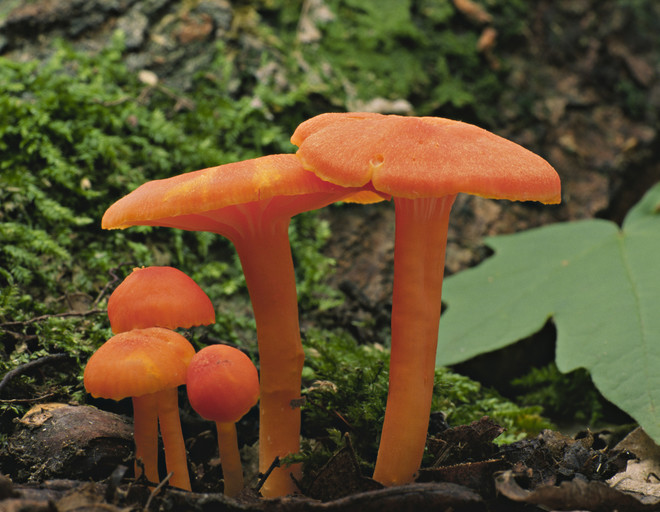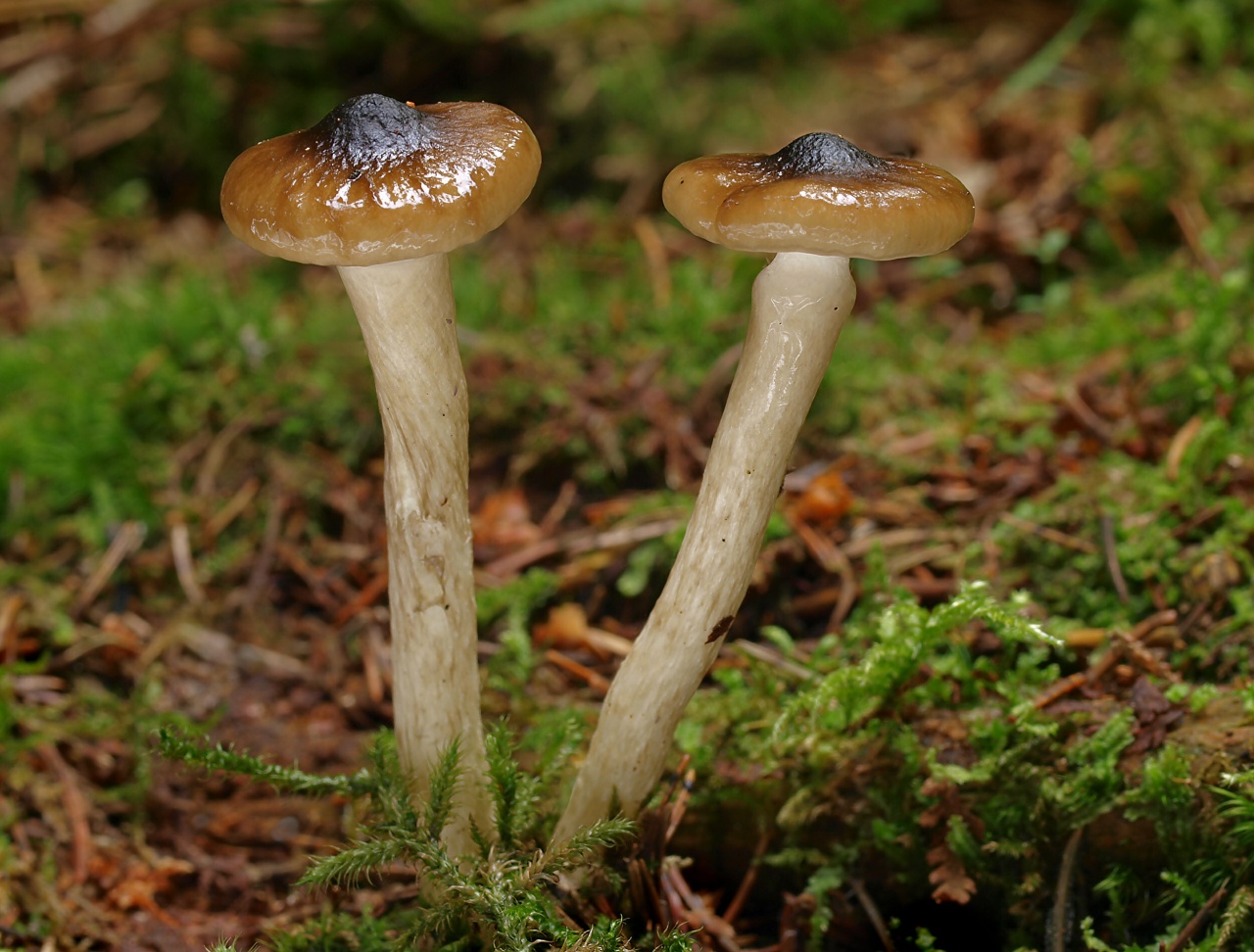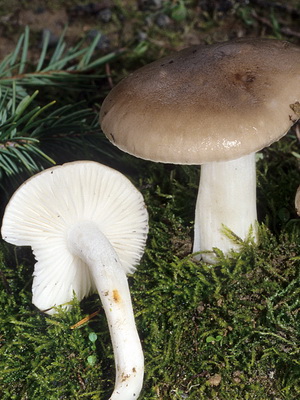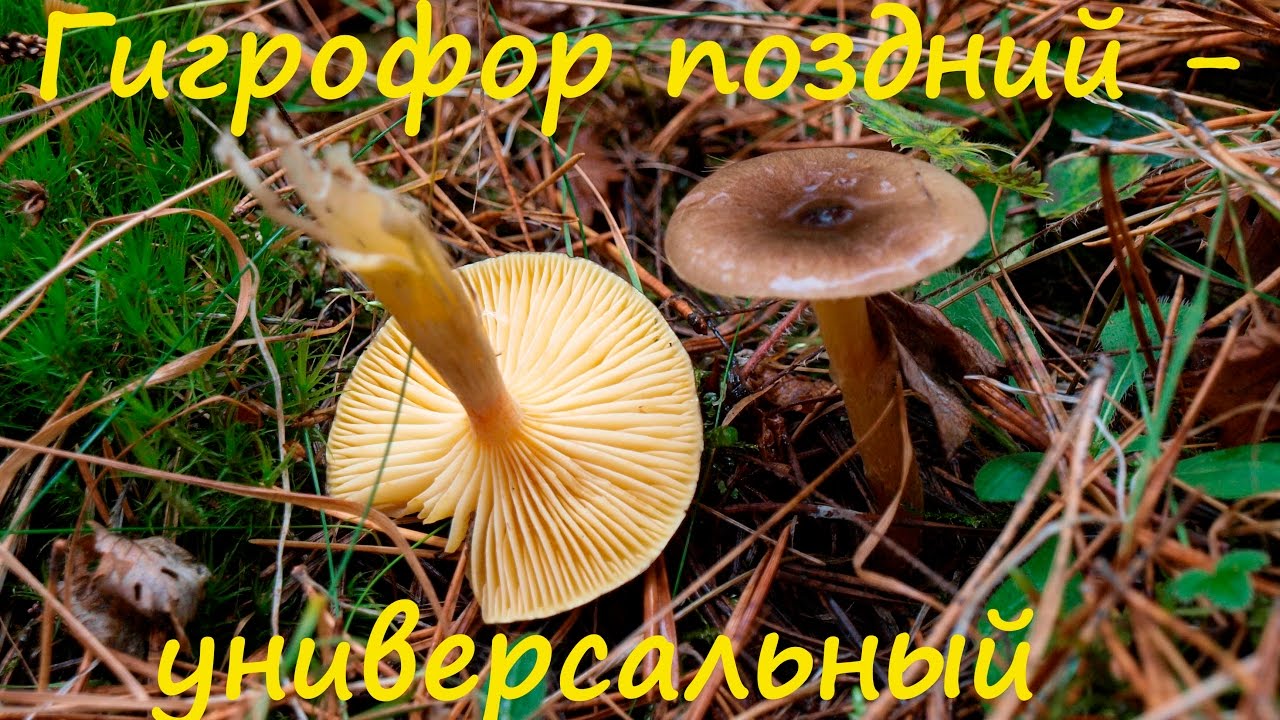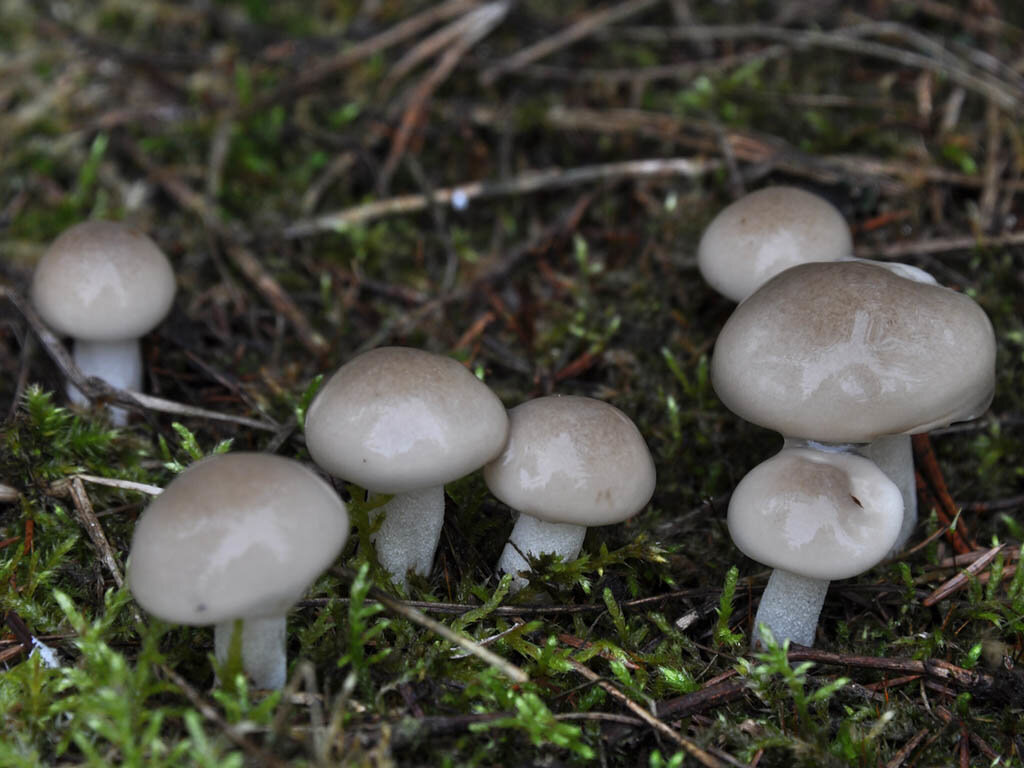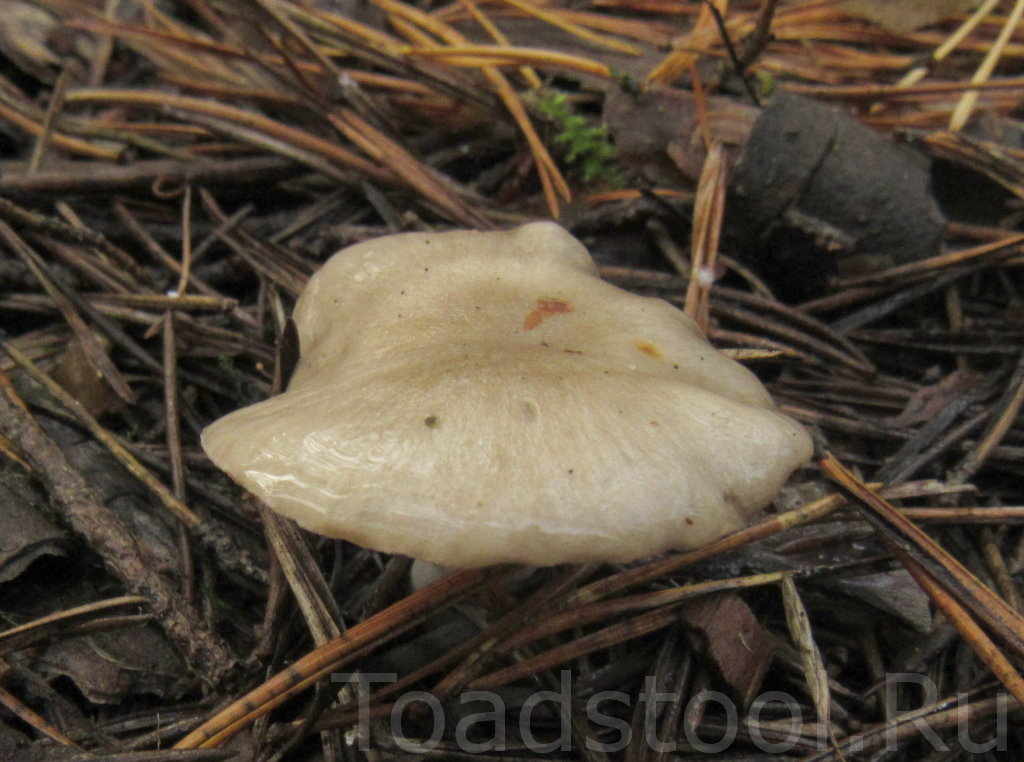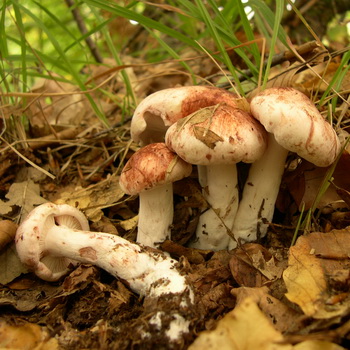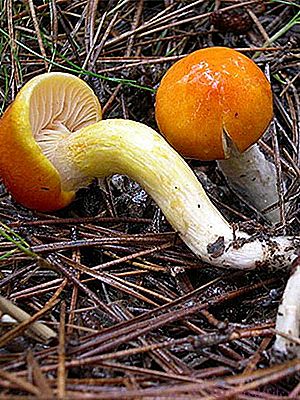Similar species
Several types of mushrooms are similar to the olive-white hygrophor:
The edible Persona hygrophor has exactly the same external characteristics, but with smaller spores and mycorrhiza formation predominantly with oak.
A rare edible species, it has a larger cap with a more pronounced tuberous outgrowth, the color does not have an olive tint, and the spores are smaller.
Edible is unknown. It differs in significantly larger sizes of the fruiting body and smaller spores. Grows in mycorrhiza mainly with pine.
 1-Gigrofor Persona 2-Gigrofor Korhonen 3-Gigrofor hiding
1-Gigrofor Persona 2-Gigrofor Korhonen 3-Gigrofor hiding
Thus, the olive-white hygrophor can be differentiated from similar species by its olive shade and mycorrhiza formation with spruce.
Cooking applications
Hygrophors have a very pleasant, mild taste. They can be boiled, fried, harvested for future use. They will be useful in any form. The only requirement is to remove the mucous cover before cooking.
Mushroom gratin
Products:
500 g of mushrooms, 1 kg of potatoes, 1 medium head of onion, 250 g of heavy cream, 2 tbsp. l. mayonnaise, 2 eggs, 2-3 cloves of garlic, salt, spices.
Preparation:
Peel the mushrooms, rinse and fry until tender, together with finely chopped onions in vegetable oil in a pan. Cut the peeled potatoes into thin slices. Put potato slices and mushroom filling in layers in a deep baking dish. To pour, mix cream, mayonnaise, eggs, garlic, salt and spices. Pour gratin with this mixture. The pouring should cover the potatoes completely. We place the dish in an oven heated to 180 degrees and bake for an hour. Serve to the table, cut into portions.
Cabbage and mushroom pie
Products:
- 200 g of mushrooms,
- 700 g of fresh white cabbage,
- 250 g minced meat,
- 2 onions, 4 eggs,
- 5 tbsp. l. flour,
- salt, herbs,
- vegetable oil.
Preparation:
To prepare the filling, the mushrooms need to be peeled, washed and boiled for 15–20 minutes in salted water. Fry chopped onions in vegetable oil until golden brown. Add mushrooms, minced meat, salt and spices to it. Bring to readiness. Add eggs, flour, herbs, salt to finely chopped cabbage. Mix thoroughly, but do not crush.
Put half of the cabbage in a frying pan greased with sunflower oil. On it - mushroom filling. Put the remaining cabbage in the last layer. Fry the pie on one side, then turn over and bring until tender over low heat, covered with a lid.
Garnish with herbs before serving.
Cauliflower casserole with mushrooms
Products:
- Forks of cauliflower,
- 250 g mushrooms
- 200 g of hard cheese
- 2 tbsp. l. mayonnaise.
Preparation:
Fry the peeled and washed mushrooms in vegetable oil. Boil cauliflower in salted water until half cooked, disassemble into inflorescences, cut into small pieces and mix with mayonnaise. Place the cabbage in a greased baking dish. Place the fried mushrooms on top, sprinkle with grated cheese and put in the oven at 180 degrees for 20 minutes. It goes well with meat.
Types of mushroom hygrophor
Fragrant, aromatic, or fragrant hygrophorus (Hygrophorus agathosmus)
An edible mushroom with a fleshy fruiting body. The hat is 4-8 cm in diameter, convex in shape, gradually becomes flat-convex, the edge is tucked up, the surface is sticky and slimy, especially at high humidity. The color of the cap is gray, yellowish brown or off-white, rarely with a green tint. The plates are rare, grow to the stem, white. The flesh is whitish or pale gray in color, soft, with a strong aroma reminiscent of bitter almonds, celery or anise, and a bland taste. Leg length 4-10 cm, thickness 0.6-1.5 cm.The stem is central, cylindrical, dry or wet, the surface is not mucous. The color of the leg is white, gradually turning gray. Spores are white.
Grows from August to September in coniferous and mixed forests. Widespread in temperate climates.
Hygrophorus yellowish white (Hygrophorus eburneus)
Edible mushroom, also known as ivory wax bonnet and cowboy handkerchief. Found in Europe, North America, North Africa.
The fruit body is white. In wet weather, the hat becomes covered with a thick layer of mucus. Feels like wax.
Early hygrophorus (Hygrophorus marzuolus)
A rare species, which is also found under the names of the hygrophor of March and snow mushroom. The diameter of the cap is 4-10 cm, the structure is thick, fleshy, the shape of the young mushroom is convex, flattens with age. The surface is curved, the edges are wavy. The skin is smooth, dry, slightly pubescent. In young mushrooms, the cap is light gray or whitish, in mature ones it is lead-gray or blackish with spots. The pulp is dense, white, turns gray with age. The aroma is weak, pleasant, the taste is not expressed. The leg is 3-8 cm long, 1.5-4 cm wide, cylindrical, curved, solid, thinning downwards. The color is whitish or gray, with a silvery tint. Spores are white.
Unlike other hygrophors, the species is very early, appears in March and grows until the beginning of May. It is found in coniferous and deciduous forests, often under beeches.
An edible mushroom used in soups and garnishes for meat dishes. Since the March hygrophor appears very early, it cannot be confused with other mushrooms, including poisonous ones.
Hygrophorus olive-white (Hygrophorus olivaceoalbus)
The diameter of the cap is 2-6 cm, the shape is hemispherical in young mushrooms, in old ones it is convex or flat, covered with a layer of mucus. The color of the cap is gray-brown or olive-brown, darker in the center, becomes lighter as it matures. The pulp is strong, white, yellow in the center, the pulp is fibrous in the stem. Aroma and taste are poorly expressed. The stem is 4-8.5 cm long and 0.4-1.0 cm thick, central, cylindrical or fusiform, olive-brown color. Spores are white.
An edible mushroom that is eaten fresh.
It grows from August to November in coniferous and mixed forests next to spruce. Widely distributed in Eurasia.
Gigrofor russula or russula (Hygrophorus russula)
A fleshy edible mushroom that grows in the deciduous forests of the Northern Hemisphere.
The diameter of the cap is 5-12 cm, the shape is hemispherical, gradually becoming convex, flattened, the edge is turned up. The surface is smooth, in wet weather it becomes sticky-mucous, in young mushrooms it is whitish or pinkish in color, with pink spots, then it becomes pink-red and in a mature mushroom - wine-red. The pulp is dense, white, pinkish on the cut, the smell is weak, flour, the taste is not pronounced. The leg is 6-8 cm long, 1-2.5 cm thick, central, tapering downward, clavate or fusiform, white with pinkish-brown spots. Spores are white.
Edible mushroom, used fresh, pickled or salted. It is considered the best in taste of all species of the family.
It grows from August to November in deciduous and mixed forests, next to an oak tree.
Fragrant gigrofor
External description
Hat: The diameter of the cap is 3-7 cm. At first, the cap has a convex shape, then it becomes flat with a protruding tubercle in the center. The skin of the cap is slimy, smooth. The surface is grayish, olive-gray or yellow-gray. At the edges, the cap is of a lighter shade. The edges of the cap remain concave inward for a long time.
Plates: soft, thick, not frequent, sometimes fork-shaped. At a young age, the plates are adherent, then they become descending. Young mushrooms have white plates, then turn dirty gray.
Leg: Leg height up to 7 cm. Diameter - up to 1 cm. The cylindrical leg thickens at the base, sometimes flattened.The leg is grayish or grayish-brown in color. The surface of the legs is covered with small, flake-like scales.
Flesh: soft, white. In rainy weather, the pulp becomes loose and watery. Has a distinct almond scent and a sweet taste. In rainy weather, a group of mushrooms spreads such a strong odor that it can be felt several meters before the place of growth.
Spore powder: white.
Spreading
Fragrant hygrophorus (higrophorus agathosmus) is found in mossy, damp places, in spruce forests. Prefers mountainous areas. Fruiting time: summer-autumn.
Similarity
Fragrant hygrophorus (higrophorus agathosmus) differs from other species by its strong almond smell. There is a similar mushroom, but its smell is more like caramel, and this species grows in deciduous forests.
Remarks
The name of the mushroom contains the word agathosmus, which translates as "Fragrant".
Mushroom photo Fragrant gigrofor from questions in recognition:
The harm and benefits of mushrooms
The beneficial properties of this mushroom are due to the content in the pulp of a large amount of amino acids, active substances, various vitamins and microelements.
The composition of hygrophors contains a large amount of easily digestible protein, therefore, in terms of nutritional value, such a mushroom can compete even with meat products.
The pulp contains the following trace elements:
It has been established that regular consumption of hygrophors can significantly improve the condition of the body:
- Toxins are eliminated.
- Overweight problems are solved.
- The work of the digestive tract improves.
- Acne disappears and skin tone improves.
- Edema under the eyes is removed.
- The condition of nails and hair improves.
The pulp contains a large amount of fiber, so the stomach can process such food for a long time, and if the hygrophor is consumed excessively, diarrhea or heartburn may appear. Nutritionists also recommend limiting the consumption of this mushroom to children under 14 years old, since the trace elements it contains can harm a fragile child's body. It is forbidden to use hygrophors in food in the presence of individual intolerance.
All currently known varieties of hygrophors are edible, so they can be easily eaten. Remember only that the golden variety can have a pungent unpleasant odor, so it is necessary to choose the right recipes for preparing certain dishes, taking into account the gastronomic characteristics of these mushrooms.
Some types of hygrophor are edible, no poisonous species have been identified.
On this page you can read the description and see photos of the most common varieties of the hygrphor mushroom: white (sweet tooth), late (brown), golden, reddish, pinkish, aromatic, larch and early. The descriptions of different types of hygrophors are similar, but there are a number of differences.
Growing a hygrophoric mushroom
Gigrofor can be grown at home. To do this, you will need a mycelium powder available in specialty stores. One package of such a powder is designed for 1 sq. m. area. Before sowing, the seeds should be mixed with a little dry soil or sand. The place for breeding the hygrophor is chosen under the trees.
The soil must be loosened to get a depression of 5-15 cm. Sprinkle a mixture of mycelium with sand on the prepared surface. Cover the top with forest or garden soil with the addition of humus.
Carefully water the site at the rate of ten liters of water per square meter of area. After that, pour the earth from above, which remained after loosening the soil. Planting mycelium can be done at any time of the year and under any type of tree. You can harvest four times a year: twice in the spring and the same in the fall.
The mushroom picker will delight you with fruits all the years as long as the tree is alive. Fertilize with humus every year to maintain high yields.This should be done only during the period when the mushrooms are not growing.
Sometimes hygrophors are grown indoors, like champignons. But this method gives a small yield and a low percentage of germination.
Although the hygrophor is not very popular among fans of "quiet hunting", it also has its fans. He deserves it with his wonderful taste and aroma, which will decorate any dish.
Gigrofor olive-white: description and photo
| Name: | Gigrofor olive-white |
| Latin name: | Hygrophorus olivaceoalbus |
| Type of: | Conditionally edible |
| Synonyms: | Sweetheart, Blackhead, Olive white woodlice |
| Specifications: |
|
| Systematics: |
|
Gigrofor olive-white - a lamellar mushroom, part of the family with the same name Gigroforovye. It belongs, like its relatives, to Basidiomycetes. Sometimes you can find other names of the species - sweet tooth, blackhead or olive-white woodlouse. It rarely grows singly, most often it forms numerous groups. The official name is Hygrophorus olivaceoalbus.
What does an olive-white hygrophor look like?
The olive-white hygrophor has a classic structure of the fruiting body, so its cap and leg are clearly pronounced. In young specimens, the upper part is conical or bell-shaped. As it matures, it becomes prostrate and even slightly depressed, but a tubercle always remains in the center. In adult mushrooms, the edges of the cap are tuberous.
The diameter of the upper part of this species is small. The maximum indicator is 6 cm. Even with a slight physical impact, it crumbles easily. The surface color varies from gray-brown to olive, with a more intense shade in the center of the cap. The pulp is of a dense consistency, when broken, it has a white color, which does not change upon contact with air. It has a pleasant mushroom smell and a slightly sweet taste.
On the back of the cap, you can see rare fleshy plates of a white or cream shade, slightly descending to the leg. In some specimens, they can branch out and intertwine. The spores are elliptical, 9-16 (18) × 6-8.5 (9) microns in size. Spore powder is white.
Its leg is cylindrical, fibrous, often curved. Its height reaches from 4 to 12 cm, and its thickness is 0.6-1 cm. Closer to the cap, it is white, and below, olive-brown scales in the form of rings are clearly visible.
Gigrofor is olive-white in damp weather, after frost it brightens noticeably
Where does the olive-white hygrophor grow
This species is widespread in Europe and North America. It can be found especially in coniferous plantings near spruce and pine. Forms whole families in humid places and lowlands.
Is it possible to eat an olive-white hygrophor
This mushroom is conditionally edible, but its taste is rated at an average level. Only young specimens can be consumed entirely. And in adult olive-white hygrophors, only caps are suitable for food, since the legs have a fibrous structure and coarsen over time.
False doubles
This type is difficult to confuse with others due to its special cap color. But some mushroom pickers find similarities with the Persona hygrophor. It is an edible counterpart. The structure of the fruiting body is very similar to the olive-white hygrophor. However, its spores are much less, and the cap is dark brown with a grayish tint. Grows in deciduous forests. The official name is Hygrophorus persoonii.
Gigrofor Persona forms mycorrhiza with oak
Collection rules and use
The fruiting period for this species begins at the end of summer and lasts until late autumn under favorable conditions.Gigrofor olive-white forms mycorrhiza with spruce, therefore it is under this tree that it is most often found. When picking, it is necessary to give preference to young mushrooms, since their taste is much higher.
This species can also be pickled, boiled and salted.
Conclusion
Gigrofor olive-white, despite its edibility, is not very popular with mushroom pickers. This is primarily due to the small size of the mushroom, average taste and a slippery layer of the cap, which requires more thorough cleaning. In addition, its fruiting period coincides with other more valuable species, so many lovers of quiet hunting prefer the latter.
Edibility, useful properties and restrictions on use
As noted earlier, the brown hygrophor is a conditionally edible species. But in some parts of Russia it is considered a very valuable and completely edible specimen. It's great for:
- frying;
- cooking;
- extinguishing;
- drying;
- freezing;
- pickling;
- salting;
- preparation of various combined dishes, soups, broths, etc.
In addition to its pleasant taste and smell, this fruit also has numerous beneficial properties. They are due to the presence in the composition of the fetus:
- proteins;
- lysine;
- fiber;
- gland;
- cysteine;
- calcium;
- and other useful substances.
Regular use of hygrophor in moderation helps to normalize the activity of the central nervous system. Experts say that this forest fruit also helps to improve the digestive processes. Woodlice mushroom contains biologically active components that are necessary to maintain and stabilize the functioning of the lymphatic system.
Good to know! If you replace meat in the diet with this fruit, then in this way you can prevent the development of type 2 diabetes.
Also, this product contains proteins, but has a low amount of calories in its composition. Therefore, it is useful to use it for the prevention of obesity, as well as in the fight against excess weight.
This is not the whole spectrum of action of the substances contained in the composition of the hygrophor. It has been proven that its inclusion in the diet contributes to the gradual but stable recovery of liver cells. The mushroom is also useful for the kidneys.
The active substances have a general tonic effect on the entire human body. Together with this, they help to strengthen blood vessels and reduce the risk of developing cardiovascular disorders. And, in particular, atherosclerotic disease.
The presence of retinol hygrophor in the composition supports the activity of the visual apparatus. Vision is normalized, fatigue and eye irritation are reduced, blood flow in the capillaries that feed them improves.
Possible harm and contraindications
Despite all the benefits of the brown hygrophor, it can be harmful to the body. For this reason, it is recommended not to abuse it, and also not to use it in food if there are contraindications:
- individual intolerance to any components contained in the composition of the fetus;
- pregnancy;
- lactation;
- diseases of the stomach and pancreas;
- epilepsy;
- hypervitaminosis;
- severe pathologies of the liver and kidneys.
At the same time, the mushroom is also prohibited for small children. Elderly people are advised to consume limited amounts of hygrophors, since the activity of their digestive system is already reduced.
Also, excessive enthusiasm for the sweet mushroom is fraught with the development of hypervitaminosis. This is a condition in which the level of certain vitamins in the body is higher than it should be normal. Such a deviation is a serious, abnormal phenomenon that requires specific treatment.
It should also be borne in mind that wood lice are capable of accumulating harmful substances, toxins, carcinogens and heavy metals. Therefore, collecting these fruits near roads or industrial enterprises is categorically unacceptable.
If you have an idea to feast on purchased mushrooms, then you should not purchase them from dubious persons.You also always need to ask where the mushroom crop was harvested, and whether there are necessary documents for the goods. These are simple rules and guidelines that, however, can help keep you healthy.
Mushroom hygrophorum late (brown)
Category: edible.


Late hygrophorus cap (Hygrophorus hypothejus) (diameter 3-7 cm): olive-brown or brown-brown, slightly convex, with edges curled inward. The surface is mucous, the edges are lighter than the center. Because of the color of the cap, this mushroom is often called the brown hygrophor.
Leg (height 4-12 cm): yellowish or olive, solid, smooth, cylindrical. Older mushrooms may be hollow. Young hygrophors have a ring that disappears over time.
Plates: yellow or light orange, sparse and thick, weakly adherent to the stem. Sometimes with the remains of the bedspread.
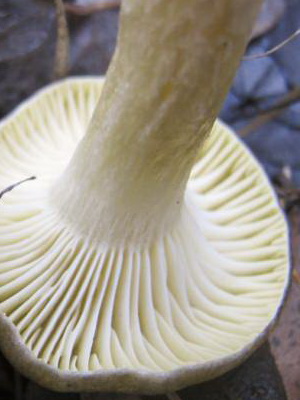

Flesh: odorless, fragile. Almost white in the cap, yellowish in the stem.
Doubles: none.
When it grows: from mid-September to almost the end of November. It appears even when the first snow falls, which is why it got the name "late".


Where to find: near pine trees in conifers or mixed
Eating: young late hygrophors have a very pleasant taste and are used for making soups or main courses. This mushroom is especially popular in the cooking of the Balkan countries.
Application in traditional medicine: not applicable.
Other names: brown hygrophor, wood lice.
Mushroom hygrophorum late (brown)
Category: edible.


Late hygrophorus cap (Hygrophorus hypothejus) (diameter 3-7 cm): olive-brown or brown-brown, slightly convex, with edges curled inward. The surface is mucous, the edges are lighter than the center. Because of the color of the cap, this mushroom is often called the brown hygrophor.
Leg (height 4-12 cm): yellowish or olive, solid, smooth, cylindrical. Older mushrooms may be hollow. Young hygrophors have a ring that disappears over time.
Plates: yellow or light orange, sparse and thick, weakly adherent to the stem. Sometimes with the remains of the bedspread.


Flesh: odorless, fragile. Almost white in the cap, yellowish in the stem.
Doubles: none.
When it grows: from mid-September to almost the end of November. It appears even when the first snow falls, which is why it got the name "late".


Where to find: near pine trees in conifers or mixed
Eating: young late hygrophors have a very pleasant taste and are used for making soups or main courses. This mushroom is especially popular in the cooking of the Balkan countries.
Application in traditional medicine: not applicable.
Other names: brown hygrophor, wood lice.

